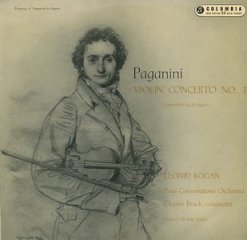The Art Of Leonid Kogan (2014) CD7: Paganini Violin Concerto No.1 in D major op.6, Cantabile op.17
The Art Of Leonid Kogan (2014) CD7: Paganini Violin Concerto No.1 in D major op.6, Cantabile op.17

1.Leonid Kogan - Paganini Violin Concerto No.1 in D Major - I. Allegro maestoso (21:28) 2.Leonid Kogan - Paganini Violin Concerto No.1 in D Major - II. Adagio (4:54) 3.Leonid Kogan - Paganini Violin Concerto No.1 in D Major - III. Rondo: Allegro spiritoso (9:11) 4.Leonid Kogan - Paganini Cantabile Op.17 (4:10) Leonid Kogan(violin) Andrei Mytnik(piano) Orchestre de la Societe des Concerts du Conservatoire Charles Bruck (conductor)
Paganini's Concerto for Violin and Orchestra No. 1 is a virtuosic tour de force and reveals not only Paganini's incredible technical ability, but also his melodic sensitivity and skillful exploitation of dramatic structure. Like many of his other works, this concerto takes inspiration from the musical language of Gioachino Rossini's operas, which were extremely popular at the time. Paganini originally composed the Concerto No. 1 in the unusual key of E flat major, in order to achieve a more brilliant tone for the violin. However, since modern concert pitches are much higher than was the norm in Paganini's era, the standard modern version of the piece is transposed to the key of D major, which also makes the very thin E string of the violin less susceptible to breakage (Paganini often broke several strings during a single concert performance). By modern standards the technical demands of the concerto are only moderate, but in Paganini's time they were considered tremendous, and many contemporaries branded the piece "unplayable." This, of course, served as valuable publicity that helped Paganini become the most popular soloist of his day. The work is indeed a catalog of such flashy techniques as extended arpeggios, left-hand pizzicati, rapid runs in thirds, fifths, and even harmonics. The work is more than a mere virtuoso showpiece, however.
Paganini's concerto is filled with elegant melodic themes, and there are moments of striking beauty. One legend holds that Paganini composed the main theme of the second movement on a one-string violin while languishing in prison under suspicion of a murder he did not commit. Such legends grow up naturally around the dynamic (and, some said, demonic) Paganini, but they also reflect the appeal and mystique of his music. Paganini's aura of mystery was amplified by his refusal to allow his works to be published during his lifetime, making it impossible for his rivals to study and master his techniques. The Concerto No. 1 was published only after his death, and it soon became a fixture in the repertoire of lesser virtuosos who were as adept, more or less, in the technical department, but not nearly as musically compeling as Paganini. Fortunately, many great twentieth century soloists have concentrated on the musicality of the piece as much as the virtuosity. --- Edward Moore, Rovi
Precious little of Niccolò Paganini's immense compositional output made it into print during his lifetime, a situation resulting less from neglect than from the virtuoso composer's own hesitation at revealing the technical tricks and tools by which he had made his name famous throughout Europe. A few pieces were published about ten years after his death, but it was not until the second decade of the twentieth century that his home city of Genoa finally allowed its enormous collection of original Paganini manuscripts to be sorted and eventually published.
The well-known Cantabile in D major, like a great deal of the music found in the Genoa collection, seems to have been composed not for public use but rather for the private enjoyment of Paganini and his circle. Here we find the composer's virtuoso fireworks tamed, his bag of tricks closed. Far removed from the pyrotechnic Caprices, the Cantabile is instead a gorgeous Italian vocalise. In a rare instance among his chamber works, Paganini passes over his favorite accompanimental instrument, the guitar (upon which he was also a virtuoso), in favor of the piano.
The Cantabile is a perfect example of three-part song form. In the opening bars of the violin melody, which begins without accompaniment, Paganini immediately betrays his indebtedness to two somewhat related influences: Italian opera and the decorative arabesque style of instrumental writing characteristic of the piano music of Chopin. A second section, in A major, follows in much the same manner as the first, climaxing in a three-measure cadential pattern whose elegant but fevered ornamentation spans nearly the entire range of the violin. As the music of the opening is reprised in the third and final section, Paganini allows the melody to unfold an octave lower than before. A wild virtuosic flourish--the only one of its kind in the piece--dissolves into the tender coda, which eventually sums up the work in two gentle pizzicati. --- Blair Johnston, Rovi
download (mp3 @320 kbs):
yandex 4shared mega mediafire cloudmailru oboom uplea








